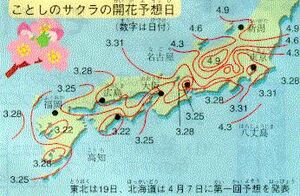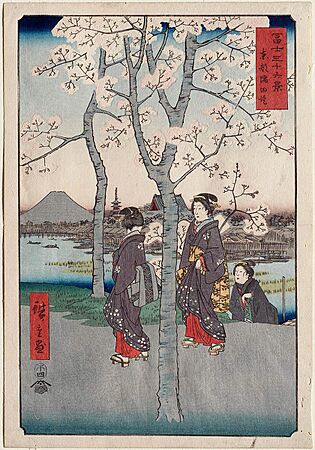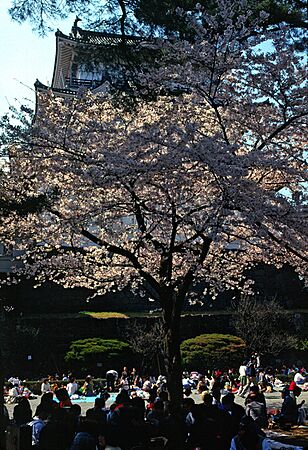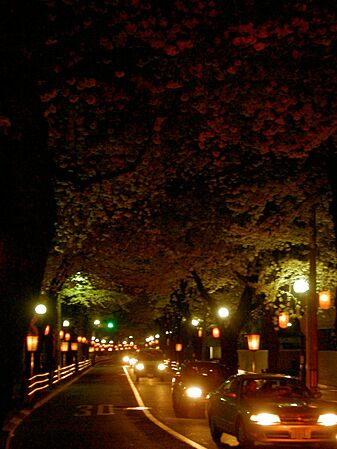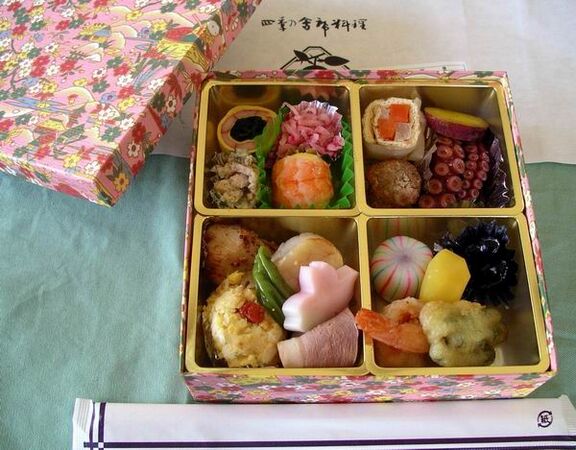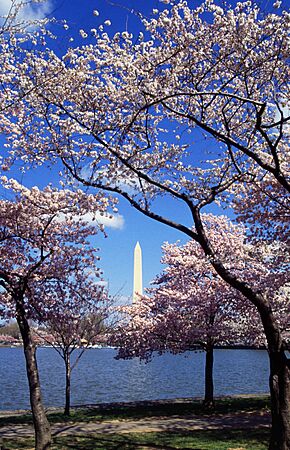Hanami facts for kids
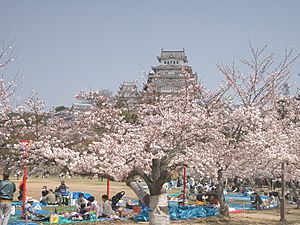
Hanami means "flower viewing" in Japanese. It's an old Japanese custom of enjoying beautiful flowers. Cherry blossoms are the most popular flowers for hanami. This tradition is over a thousand years old. It is still very popular in Japan today.
Hanami happens in the spring. Cherry blossoms only last for about one or two weeks. The cherry trees usually flower in late March and early April. The blossoms do not stay fresh for long. After a short time, they fall from the trees.
An older type of hanami also exists in Japan. It celebrates plum blossoms instead of cherry blossoms.
Contents
The History of Hanami
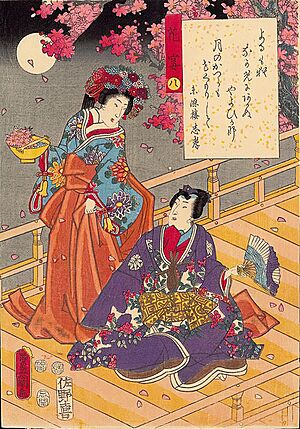
The practice of hanami started many centuries ago. It began during the Nara Period (710–784). At that time, the Chinese Tang Dynasty influenced Japan a lot. One of these influences was enjoying flowers.
At first, people admired plum blossoms. But by the Heian Period (794–1185), cherry blossoms, called sakura, became more popular. Japanese people thought sakura were sacred. They were so important that they are still a cultural symbol of Japan.
People believed that kami (gods) lived inside the trees. Hanami parties first helped people guess how good the year's harvest would be. They also helped announce the time to plant rice. People made offerings at the roots of sakura trees. After the ceremony, they drank sake as part of the offering.
How Hanami Parties Began
Emperor Saga of the Heian Period started this custom in the Imperial Court in Kyoto. He held parties to view the flowers. People enjoyed sake and feasts under the blooming sakura branches. This is thought to be how hanami parties began in Japan.
Poems were written to praise the delicate flowers. They were seen as a metaphor for life itself. Life is beautiful, but it lasts for a very short time. This idea of life being 'temporary' is very important in Japanese culture. It is often seen as a good way to live. For example, samurai believed life should end when it is still beautiful and strong. They did not want it to slowly get old and weak.
Heian era poets wrote about how the short life of sakura reminded them that life is short.
| If there were no cherry blossoms in this world How much more tranquil our hearts would be in Spring. |
||
|
Ariwara no Narihira (825–880)
|
||
The word "hanami" first meant "cherry blossom viewing" in the Heian era novel The Tale of Genji. After that, in tanka and haiku poetry, "flowers" usually meant "sakura." The words "hanami" and "flower party" were only used for viewing sakura blossoms.
Hanami Becomes Popular
At first, only the Imperial Court celebrated hanami. But the samurai nobility also started celebrating it during the Azuchi-Momoyama Period (1568–1600). During these years, Toyotomi Hideyoshi held huge hanami parties. These parties were in Yoshino and Daigo. This made the celebration very popular across all of Japanese society.
Soon after, farmers began their own custom. They would climb nearby mountains in springtime. They would have lunch under the blooming cherry trees. This practice was called the "spring mountain trip." It combined with the nobles' custom to form the urban culture of hanami.
By the Edo Period (1600–1867), everyone took part in the celebrations. This was partly because Tokugawa Yoshimune planted many cherry blossom trees to encourage it. Under the sakura trees, people had lunch and drank sake in happy feasts.
Hanami Today
Japanese people still follow the tradition of hanami today. People fill parks to eat and drink under the flowering trees. In many parts of Japan, cherry blossom days happen when school and work start after vacation. So, welcoming parties often begin with hanami.
People often go to parks many hours early. They want to save the best spots for their hanami celebrations with friends, family, and co-workers. In many places, like Ueno Park, paper lanterns are hung. This allows people to view the flowers at night.
Cherry Blossom Forecast
The blossom forecast, also called the cherry blossom front, is announced every year. The Japan Meteorological Agency provides this forecast. The first cherry blossoms appear in the subtropical southern islands of Okinawa. On the northern island of Hokkaido, they bloom much later.
In most large cities like Tokyo, Kyoto, and Osaka, the cherry blossom season is usually in late March and early April. Television and newspapers closely follow this "cherry blossom front." It slowly moves from south to north across Japan.
Hanami Outside Japan
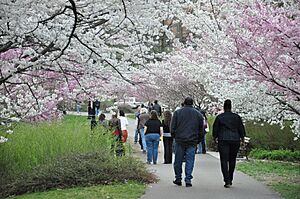
Hanami is also popular outside of Japan. There are hanami celebrations in Korea, the Philippines, China, and many other places.
In 1912, Japan gave 3,000 sakura trees to the United States. This gift celebrated the friendship between the two nations. These trees were planted in Washington, D.C.. Another 3,800 trees were added in 1956. These sakura trees are a popular tourist attraction. Every year, the National Cherry Blossom Festival happens when they bloom in early Spring.
In Macon, Georgia, another cherry blossom festival is celebrated every spring. It is called the International Cherry Blossom Festival. Macon is known as the "Cherry Blossom Capital of the World." This is because 300,000 sakura trees grow there.
In Brooklyn, New York, the Annual Sakura Matsuri Cherry Blossom Festival takes place in May. It is held at the Brooklyn Botanic Garden. This festival started in 1981 and is very popular.
Picture gallery
-
"Yoshitsune and Benkei Viewing Cherry Blossoms", by artist Tsukioka Yoshitoshi, 1885
-
Hanami party at Odawara Castle.
-
Sakura trees with paper lanterns in Tokyo.
-
Sakura trees in Washington, D.C.
-
International Cherry Blossom Festival in Macon, Georgia, United States.
Related pages
Images for kids
-
'Shidare-zakura' is the first recorded cultivar in Japan.
-
'Kanzan' is a double-flowered cultivar developed in the Edo period. It has 20 to 50 petals in a flower.
-
Yoshino cherry ('Somei-yoshino') has rapidly spread throughout Japan since the Meiji period.
-
Hanami through the "Tunnel" at Japan Mint in Osaka, 2016
-
Hanami at Maruyama Park behind Yasaka Shrine in Kyoto, 2014
-
Hanami in Ueno Park
-
Hanami in Parc de Sceaux, Hauts-de-Seine
See also
 In Spanish: Hanami para niños
In Spanish: Hanami para niños


